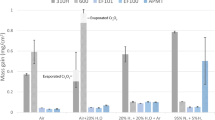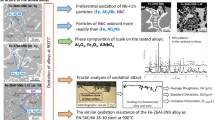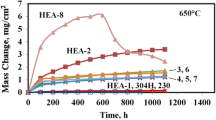Abstract
The cyclic-oxidation behavior of commercial iron-base 800-series chromia-scale-forming alloys was studied at 1000°C in still air. Each thermal cycle consisted of one day at temperature followed by air cooling to room temperature. Two different types of 800-series alloys were studied (800 and 800HT), with each type being supplied by two different producers. Although the alloys were of similar chemical composition, their variations in minor-constituent contents were apparently sufficiently different to cause marked differences in oxidation behavior. Compared to the 800 alloys, the higher-strength 800HT alloys generally performed the worst, undergoing rapid weight-loss kinetics after an initial period of relatively protective oxidation. The time required for the commencement of rapid weight-loss kinetics depended significantly on the producer of the 800HT alloy. In general, however, the 800HT alloys developed protrusion of Ti- and Cr-rich oxides into the alloy along the alloy/scale interface, which promoted spallation and poorer cyclic-oxidation resistance. The formation of Si-rich oxide particles in the vicinity of the alloy/scale interface could improve cyclic-oxidation resistance; however, higher Si contents would cause internal Si-rich oxide formation and promote the formation of Ti- and Cr-rich oxide protrusions at the alloy/scale interface. Good cyclic-oxidation resistance requires optimization of the minor-element constituents, Si, Ti, and Al in particular.
Similar content being viewed by others
REFERENCES
M. A. Cordovi, in A Status Review of Alloy 800, S. F. Pugh, ed. (Oxfordshire: AERE Harwell, The British Nuclear Energy Society, 1975), p. 2.
G. Y. Lai, High-Temperature Corrosion of Engineering Alloys, (ASM International, 1990), p. 29.
H. Hindam and D. P. Whittle, Oxidation of Metals, 18, 245 (1982).
B. Gleeson and M. A. Harper, Oxidation of Metals, 49, 373 (1998).
J. H. Chen, P. M. Rogers, and J. A. Little, Materials Science Forum, 57, 251–254 (1997).
D. Caplan and M. Cohen, Journal of the Electrochemical Society, 112, 471 (1965).
H. E. Evans, D. A. Hilton, R. A. Holm, S. J. Webster, Oxidation of Metals, 19, 19 (1983).
F. H. Stott, G. J. Gabriel, F. I. Wei, and G. C. Wood, Werkstoffe und Korrosion, 38, 521 (1987).
F. H. Stott, F. I. Wei, and C. A. Enahoro, Werkstoffe und Korrosion 40, 198 (1989).
F. H. Stott, Materials Characterization 28, 311 (1992).
G. C. Wood, F. H. Stott, Materials Science Technology 3, 519 (1987).
M. A. Harper, and L. R. Walker, Corrosion 2001, NACE, 01154, 2001.
S. Leistikow, in A Status Review of Alloy 800 S. F. Pugh, ed. (Oxfordshire: AERE Harwell, The British Nuclear Energy Society, 1975), p. 102.
F. Delaunay, C. Berthier, D. Galy, J. M. Lameille, and M. Lenglet, Microscopy of Oxidation-3, (The Institute of Materials, London, 1997), p. 587.
M. A. Harper, and B. Gleeson, Cyclic-Oxidation of High Temperature Materials, EFC Publications, NO. 27, 273 (1999).
H. J. Yearian, H. E. Boren, and R. E. Warr, Corrosion, 12, 561 (1956).
M. D. Merz, Metallurgical Transactions A, 11, 71 (1980).
M. A. Dayananda, and C. W. Kim, Metallurgical Transactions A, 10, 1333 (1979).
M. A. Dayananda, Metallurgical Transactions A, 14, 1851 (1983).
C. Wagner, Journal of the Electrochemical Society, 99, 369 (1952).
K. P. Lillerud, and P. Kofstad, in High Temperature Corrosion, R. A. Rapp, ed. (NACE, Houston, TX, 1983).
M. P. Brady, D. T. Hoelzer, E. A. Payzant, P. F. Tortorelli, J. A. Horton, I. M. Anderson, L. R. Walker, and S. K. Wrobel, Journal of Materials Research, 16, 2784 (2001).
U. Krupp, and H.-J. Christ, Metallurgical and Materials Transactions A, 31, 47 (2000).
K. S. Chan, Metallurgical and Materials Transactions A 28, 411 (1997).
H. E. Evans, International Materials Reviews, 40, 1 (1995).
C. O. Moon, and S. B. Lee, Oxidation of Metals, 39, 1 (1993).
R. C. Lobb, J. A. Sasse, and H. E. Evans, Materials Science and Technology, 5, 828 (1989).
K. Kusabiraki, and Y. Nakao, in High-Temperature Corrosion and Protection 2000, Toshio Narita et al. eds., (Hokkaido, Japan, 2000), p. 105.
J. Litz, A. Rahmel, M. Schorr, and J. Weiss, Oxidation of Metals, 32, 167 (1989).
J. H. Chen, P. M. Rogers, and J. A. Little, Oxidation of Metals, 47, 381 (1997).
Author information
Authors and Affiliations
Corresponding author
Rights and permissions
About this article
Cite this article
Li, B., Gleeson, B. Effects of Minor Elements on the Cyclic-Oxidation Behavior of Commercial Fe-Base 800-Series Alloys. Oxidation of Metals 62, 45–69 (2004). https://doi.org/10.1023/B:OXID.0000038785.16792.3d
Issue Date:
DOI: https://doi.org/10.1023/B:OXID.0000038785.16792.3d




